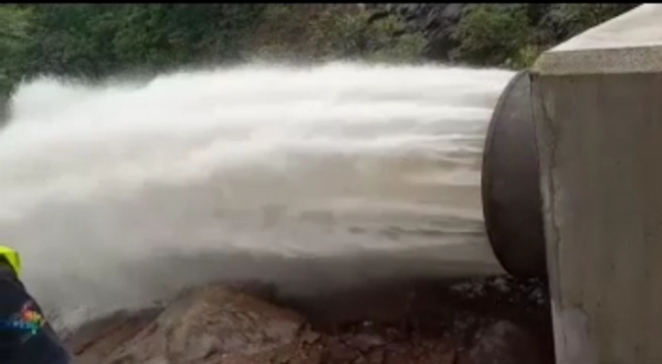The Guma Dam at Mile 13, which is responsible for 95% of the water supply to residents of Freetown, spilled on Tuesday 16th August, 2022. The spilling of the dam is an annual occurrence that assures Guma Valley Water Company (GVWC) will be able to provide a daily average of 70,000 cubic meters of water supply (70 million liters daily) for the next 12 months.
The Dam at Mile 13 is located at 862ft above sea level and once that level is attained, the dam will spill the excess water into the No.2 River basin and finally discharged into the Atlantic Ocean.
The spilled water is discharged in a control manner so that it does not cause harm or injury to individuals and settlements downstream at the dam.
The spilling of the dam gives Guma the opportunity to scour the dam, a process by which the dam is cleared of sediments, silts and reduces the turbidity of the raw water.
This year’s scouring process also enabled Guma to test the new Scour and Gate valves that were recently installed under the Freetown Water Supply Rehabilitation Project, sponsored by the Foreign Commonwealth Development Office (FCDO).
The Scour and Gate valves are critical components of the water supply infrastructure, together acting as a fail-safe mechanism. During an emergency it can be used to empty the dam quickly and safely without causing damage to the population downstream.
Speaking after the exercise, the Head of the Guma Treatment Plant, Ing. Bernadette Kargbo said the turbidity of the raw water was tested and the result showed that it is below 5 Nephelometric Turbidity Units (NTU), well within the generally accepted range.
Commenting on the dam spilling, the Managing Director of the GVWC, Ing. Maada S. Kpenge said it is a sad situation that the dam is quite small for a city the size of Freetown, and every rainy season the dam quickly fills up and overflows for weeks, with the water flowing straight out to the sea.
Ing. Kpenge said there is an urgent need to capture and store the spill water. “We have done some calculations and it shows that we are losing 518.4 million liters every day; at our current production output, that amount of water can serve Freetown for 6 days. If the dam overflows for 30 days, it will be equivalent to 6 months of water supply to Freetown”.
The Guma MD added that capturing and storing the spill water in a reservoir downstream at the No. 2 River is one of the strategic projects highlighted in the Freetown Water Supply Master Plan. The increased storage of raw water will enable Guma to maintain a higher flow to Freetown, even during the dry season months.
Ing. Kpenge however stressed that Freetown will still need all other strategic water supply projects like the River Rokel, Orugu and Kongo water supply projects; new dams and storage reservoirs at Hamilton, York, Big Water, Waterloo and Hastings to cater for the needs of Western Area’s ever-growing population.



 Post a comment
Post a comment








